|
Accounting | Business | Computer Science | General Studies | Math | Sciences | Civics Exam | Help/Support | Join/Cancel | Contact Us | Login/Log Out Elementary Statistics Homework 1 2 3 4
5-6 6.3-7
8-10 | Tests Chapter 1-3
4 5-6 6.3-7 8-10 Final Review
Elementary Statistics
(STA2023)
Chapter 5 - 6 Test Assume that a procedure
yields a binomial distribution with n = 5 trials and a probability of success
of p = 0.30.
Use a binomial probability table to find the probability that the number of successes x is exactly 1. Click on the icon to view the binomial probabilities table.  P(I) = 0.360 (Round to three decimal places as needed.)
Find the area of the
shaded region. The graph to the right depicts IQ scores of adults, and those
scores are normally distributed with a
mean of 100 and a standard deviation of 15. 
x = 95, x = 125 Click to view page 1 of the table The area of the shaded region is 0.5818. (Round to four decimal places as needed.) We do not need any tables to solve this. Use the TI-84 Plus! First, we calculate TWO z-values for this. Follow the steps below! Lower z-value z = x – mean / standard deviation z = 95 – 100 / 15 = -0.33333333 round to z = 0.33 Upper z-value z = 125 – 100 / 15 z = 25 / 15 = 1.666666666667 round to z = 1.67 Lower z-value = -0.33 Upper z-value = 1.67 TI84 Plus Instructions Instructions TI84 Plus Instructions Instructions Press 2ND | VARS Normalcdf: -9999 / -.33 / 0 / 1 | Enter, then ENTER again. = 0.3707000449 (round to 4 decimals) 0.3707 Normalcdf: -9999 / 1.67 / 0 / 1 | Highlight Paste > Enter, then ENTER again. = .952540341 (round to 4 decimals (.9525) 0.9525 - 0.3707 = 0.5818 Which of the following does NOT describe the standard normal distribution? Choose the correct answer below. A. It is a normal distribution with a mean of O and a standard deviation of 1. B. The graph is symmetric. C. The total area under the curve must equal 1. D. The graph is uniform. Find the area of the shaded region. The graph depicts the standard normal distribution of bone density scores with mean 0 and standard deviation 1.  The area of the shaded re Ion is 0.7148. Lower z-value z = x – mean / standard deviation z = -0.91 – 0 / 1 = -0.91 round to z = 0.33 Upper z-value z = 1.26 – 0 / 1 z = 25 / 15 = 1.26 round to z = 1.67 Lower z-value = -0.91 Upper z-value = 1.26 TI84 Plus Instructions Instructions TI84 Plus Instructions Instructions Press 2ND | VARS Normalcdf: -9999 / -.33 / 0 / 1 | Highlight Paste, Enter, then ENTER again. = 0.1814 (round to 4 decimals) 0.1814 Normalcdf: -9999 / 1.26 / 0 / 1 | Highlight Paste, Enter then ENTER again. = .89616 (round to 4 decimals (.9525) 0.8962 - 0.1814 = 0.7148 Find the area of the shaded region. The graph to the right depicts IQ scores of adults, and those scores are normally distributed with a  The area of the shaded region is 0.0228 (Round to four decimal places as needed.) Upper z-value z = 70 – 100 / 15 = -2 TI84 Plus Instructions Instructions TI84 Plus Instructions Instructions Press 2ND | VARS Normalcdf: -9999 / -2 / 0 / 1 | Highlight Paste, Enter then ENTER again. = 0.022750062 (round to 4 decimals) 0.1814 Assume that when adults with smartphones are randomly selected, 58% use them in meetings or classes. If 30 adult smartphone users are randomly selected, find the probability that exactly 24 of them use their smartphones in meetings or classes. The probability is 0.0068. TI84 Plus Instructions Instructions TI84 Plus Instructions Instructions Press 2ND | VARS | binompdf : Trials 30 / P: .58 / X value: 24 Highlight Paste > Enter > Enter. 0.0068452529 (round to 0.0068) Based on a survey, assume that 32% of consumers are comfortable having drones deliver their purchases. Suppose that we want to find the probability that when four consumers are randomly selected, exactly two of them are comfortable with delivery by drones. Identify the values of n, x, p, and q. The value of n is 4. (Type an integer or a decimal. Do not round.) The value of x is 2. (Type an integer or a decimal. Do not round.) The value of p is 0.32. (Type an integer or a decimal. Do not round.) The value of q is 0.68. (Type an integer or a decimal. Do not round.) The value of n is 4. (is given “four consumers are randomly selected”) The value of x is 2. (is given “exactly two of them are comfortable with delivery by drones”) The value of p is 0.32 (is given “32% of consumers are comfortable” convert 32% to decimal) The value of q is 0.68. (subtract the value of p (0.32) from 100)) Determine whether the given procedure results in a binomial distribution (or a distribution that can be treated as binomial). If the procedure is not binomial, identify at least one requirement that is not satisfied. Nine different senators from the current U.S. Congress are randomly selected without replacement, and whether or not they’ve served over 2 terms is recorded. Does the probability experiment represent a binomial experiment? A. Yes, because the experiment satisfies all the criteria for a binomial experiment. B. No, because there are more than two mutually exclusive outcomes for each trial. C. No, because the trials of the experiment are not independent, and the probability of success differs from trial to trial. D. No, because the experiment is not performed a fixed number of times. Assume that a randomly selected subject is given a bone density test. Those test scores are normally distributed with a mean of 0 and a standard deviation of 1. Find the probability that a given score is less than -2.02 and draw a sketch of the region. Sketch the region. Choose the correct graph below.  The probability is 0.0217. (Round to four decimal places as needed.) z-value = x – mean / standard deviation z-value = -2.02 = 0 / 1 = -2.01 TI84 Plus Instructions Instructions TI84 Plus Instructions Instructions Press 2ND | VARS Normalcdf: -9999 / -2.02 / 0 / 1 | Highlight Paste, Enter then ENTER again. = 0.0216916245 (round to 4 decimals) 0.0217 Assume that the readings on the thermometers are normally distributed with a mean of 00 degrees and standard deviation of 1.000 C. A thermometer is randomly selected and tested. Draw a sketch and find the temperature reading corresponding to Upper P94, the 94th percentile. This is the temperature reading separating the bottom 94% from the top 6%.  The temperature for Upper P94 is approximately 1.550. TI84 Plus Instructions Instructions TI84 Plus Instructions Instructions Press 2ND | VARS invNorm: area: .94 / mu: 0 / sd: 1 1.554773593 (round to 1.55) Use the calculator to find the indicated critical value. z0.09 z0.09 = 1.34 TI84 Plus Instructions Instructions TI84 Plus Instructions Instructions Press 2ND | VARS invNorm: area: .09 / mu: 0 / sd: 1 -1.340755035 (this will be positive, because the critical value is always positive) 1.34 Find the indicated z score. The graph depicts the standard normal distribution with mean 0 and standard deviation 1. 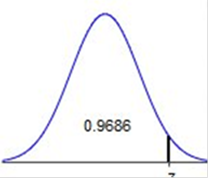 The indicated z score is 1.86. (Round to two decimal places as needed.) TI84 Plus Instructions Instructions TI84 Plus Instructions Instructions Press 2ND | VARS invNorm: area: .9686 / mu: 0 / sd: 1 1.860604847 (round to 1.86) 1.86 Assume that a randomly selected subject is given a bone density test. Bone density test scores are normally distributed with a mean of 0 and a standard deviation of 1. Draw a graph and find P8, the 8th percentile. This is the bone density score separating the bottom 8% from the top 92%. Which graph represents P8 Choose the correct graph below. Sketch the region. Choose the correct graph below. 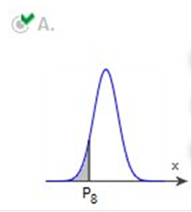 The probability is -1.41 (Round to four decimal places as needed.) TI84 Plus Instructions Instructions TI84 Plus Instructions Instructions Press 2ND | VARS Normalcdf: Lower: -9999 / Upper: .08 / Mu: 0 / Sd: 1 -1.405071561 (round to -1.42) -1.42 Find the indicated IQ score. The graph to the right depicts IQ scores of adults, and those scores are normally distributed with a mean of 100 and a standard deviation of 15. 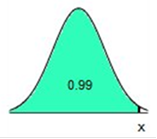 1 - 0.99 = 0.01 Press 2ND | VARS invNorm: .01 / = -2.326347877 (round to -2.33) 100 - (-2.33 · 15) = 134.95 (135) Five males with an X-linked genetic disorder have one child each. The random variable x is the number of children among the five who inherit the X-linked genetic disorder. Determine whether a probability distribution is given. If a probability distribution is given, find its mean and standard deviation. If a probability distribution is not given, identify the requirements that are not satisfied. x P(x) 0 0.034 1 0.145 2 0.321 3 0.321 4 0.145 5 0.034 Does the table show a probability distribution? Select all that apply. A. Yes, the table shows a probability distribution. B. No, the random variable x is categorical instead of numerical. C. No, not every probability is between 0 and 1 inclusive. D. No, the sum of all the probabilities is not equal to 1. E. No, the random variable x's number values are not associated with probabilities. Find the mean of the random variable x. Select the correct choice below and, if necessary, fill in the answer box to complete your choice. A. mu 2.5 child(ren) (Round to one decimal place as needed.) B. The table does not show a probability distribution. x P(x) 0 x 0.034 0 1 x 0.145 0.145 2 x 0.321 0.642 3 x 0.321 0.963 4 x 0.145 0.58 5 x 0.034 0.17 Mean = 2.5 Please note to find the mean from L1, you will need to use L2 in the FreqList. Just to be sure, go to: STAT > CALC > 1-Var Stats and FreqList: hit 2ND and the number 2.  STAT EDIT LINE ENTER DATA/NUMBERS in L1 & L2 Then STAT CALC VAR STATS CALCULATE x̅ = Mean Find the standard deviation of the random variable x. Select the correct choice below and, if necessary, fill in the answer box to complete your choice. A. sd = 1.1 child(ren) (Round to one decimal place as needed.) B. The table does not show a probability distribution. x P(x) x2 0 0.034 0 x = 0 1 0.145 1 x = 0.145 2 0.321 4 x = 1.284 3 0.321 9 x = 2.889 4 0.145 16 x = 2.32 5 0.034 25 x = 0.85 7.488 Please note to find the mean from L1, you will need to use L2 in the FreqList. Just to be sure, go to: STAT CALC 1-Var Stats FreqList: press 2ND and the number 2.  STAT EDIT LINE ENTER DATA/NUMBERS in L1 & L2 Then STAT CALC VAR STATS CALCULATE σx = standard deviation Find the area of the shaded region. The graph depicts the standard normal distribution of bone density scores with mean 0 and standard deviation 1. 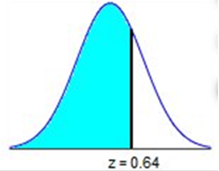 The area of the shaded region is 0.7389. (Round to four decimal places as needed.) TI84 Plus Instructions Instructions TI84 Plus Instructions Instructions Press 2ND | VARS Normalcdf: Lower: -9999 / Upper: .64 / Mu: 0 / Sd: 1 = 0.7309137655 (round to 0.7389) Determine whether the following value is a continuous random variable, discrete random variable, or not a random variable. a. The number of textbook authors now eating a meal. b. The hair color of adults in the United States. c. The height of a randomly selected person. d. The distance a football travels in the air after being thrown. e. The amount of rainfall in a country in a year. f. The number of hits to a website in a week. a. Is the number of textbook authors now eating a meal a discrete random variable, continuous random variable, or not a random variable? A. It is a discrete random variable. B. It is a continuous random variable. C. It is not a random variable. b. Is the hair color of adults in the United States a discrete random variable, continuous random variable, or not a random variable? A. It is a discrete random variable. B. It is a continuous random variable. C. It is not a random variable. c. Is the height of a randomly selected person a discrete random variable, continuous random variable, or not a random variable? A. It is a continuous random variable. B. It is a discrete random variable. C. It is not a random variable. d. Is the distance a football travels in the air after being thrown a discrete random variable, continuous random variable, or not a random variable? A. It is a discrete random variable. B. It is a continuous random variable. C. It is not a random variable. e. Is the amount of rainfall in a country in a year a discrete random variable, continuous random variable, or not a random variable? A. It is a discrete random variable. B. It is a continuous random variable. C. It is not a random variable. f. Is the number of hits to a website in a week a discrete random variable, continuous random variable, or not a random variable? A. It is a discrete random variable. B. It is a continuous random variable. C. It is not a random variable. Assume that a randomly selected subject is given a bone density test. Those test scores are normally distributed with a mean of 0 and a standard deviation of 1. Draw a graph and find the probability of a bone density test score greater than -1.94. Sketch the region. Choose the correct graph below. 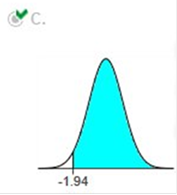 The probability is 0.9738. (Round to four decimal places as needed.) TI84 Plus Instructions Instructions TI84 Plus Instructions Instructions *Please note the LOWER would be positive 9999 in this case because it is to the left! *The PROBILITY will also be positive for the same reason although the solution will display a negative! Press 2ND | VARS Normalcdf: Lower: 9999 / Upper: -1.94 / Mu: 0 / Sd: 1 (LOWER would be positive 9999 in this case) -0.9730102245 (PROBILITY will also be positive) Do not forget to round to 4 decimal places: 0.9738 The lengths of pregnancies are normally distributed with a mean of 266 days and a standard deviation of 15 days. a. Find the probability of a pregnancy lasting 309 days or longer. b. If the length of pregnancy is in the lowest 3%, then the baby is premature. Find the length that separates premature babies from those who are not premature. a. The probability that a pregnancy will last 309 days or longer is 0.0021. (Round to four decimal places as needed.) b. Babies who are born on or before 238 days are considered premature. (Round to the nearest integer as needed.) Explanation: a. 309 - 266 / 15 = 2.866666667 (round to 2.87) TI84 Plus Instructions Instructions TI84 Plus Press 2ND | VARS Normalcdf: ->>> 9999 / 2.87 / 0 / 1 = 0.0020524243 (round to 0.0021) b. Press 2ND | VARS invNorm: area: .03 / 0 / 1 = -1.88079361 (-1.88) 266 + (-1.88 · 15) = 237.8 (round to 238) Based on a poll, 60% of adults believe in reincarnation. Assume that 66 adults are randomly selected and find the indicated probability. a. What is the probability that exactly 5 of the selected adults believe in reincarnation? The probability that exactly 5 of the 6 adults believe in reincarnation is 0.187. (Round to three decimal places as needed.) TI84 Plus Instructions Instructions TI84 Plus Instructions Instructions Press 2ND | VARS Binompdf: Trials: 6 / P: .6 / X value: 5 .186624 b. The probability that all of the selected adults believe in reincarnation is 0.047. (Round to three decimal places as needed.) TI84 Plus Instructions Instructions TI84 Plus Instructions Instructions Press 2ND | VARS Binompdf: Trials: 6 / P: .6 / X value: 6 .046656 Ted is not particularly creative. He uses the pickup line "If I could rearrange the alphabet, I'd put U and I together. " The random variable x is the number of women Ted approaches before encountering one who reacts positively. Determine whether a probability distribution is given. If a probability distribution is given, find its mean and standard deviation. If a probability distribution is not given, identify the requirements that are not satisfied. x P(x) 0 0.001 1 0.008 2 0.028 3 0.063 a. Does the table show a probability distribution? Select all that apply. A. Yes, the table shows a probability distribution. B. No, the random variable x is categorical instead of numerical. C. No, the random variable x's number values are not associated with probabilities. D. No, the sum of all the probabilities is not equal to 1. E. No, not every probability is between 0 and 1 inclusive. b. Find the mean of the random variable x. Select the correct choice below and, if necessary, fill in the answer box to complete your choice A. mu = women (Round to one decimal place as needed.) B. The table does not show a probability distribution. x P(x) 0 0.001 0 1 0.008 0.008 2 0.028 0.056 3 0.063 0.189 Mean = 0.253 c. Find the standard deviation of the random variable x. Select the correct choice below and, if necessary, fill in the answer box to complete your choice. A. SD = women (Round to one decimal place as needed.) B. The table does not show a probability distribution. |
| Home |
Accounting & Finance | Business |
Computer Science | General Studies | Math | Sciences |
Civics Exam |
Everything
Else |
Help & Support |
Join/Cancel |
Contact Us |
Login / Log Out |